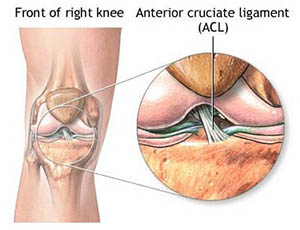
In today’s realm of high school and college sports, knee injuries are at an all-time high. More alarmingly, it is a well-known fact that women, in particular, are at a great risk of sustaining lower-extremity injuries. Scientists are now working to establish why this is.
One of the most debilitating injuries young athletes can suffer from is a torn ligament. In fact, over 90,000 anterior cruciate ligament (ACL) tears occur in high school and college athletes annually.
The ACL, which connects the thighbone to the shinbone, is crucial for knee stability. Also one of the four major ligaments that secure the knee joint, the ACL—if torn—can result in significant consequences. Typically, surgery is performed to replace the torn ligament, but some partial tears can heal without surgery. Once surgery is deemed necessary, patients and surgeons decide whether to replace the torn ligament. This is typically done with a piece of tendon from a different part of the patient’s body or from a donor. Months of recovery and rehabilitation follow this surgery. Following the difficult recovery process, patients, and especially women, are at a great risk of developing arthritis.
“One movement means a year out. That’s all it takes—one bad step, one bad jump or an extra bit of weight in the wrong direction at the wrong time,” said Stephen Chaconas, associate director of elite-level travel soccer for the Capital Area Soccer League in Raleigh, North Carolina. Chaconas’ league for four to 18-year-olds has seen seven ACL tears in the past year—all but one of which occurred in females.
This seemingly gendered injury has sparked the curiosity of many orthopedic surgeons. Professor and director of Sports Medicine at Ohio State University’s Sports Health and Performance institute, Timothy Hewett, says that when young women go out onto the soccer field or basketball court, “they don’t have the power.” Research shows that during puberty, boys grow muscles much faster than girls, which accounts for an increase in power in young male athletes. Due to female athlete’s comparative lack of power, they are forced to depend heavily on certain muscles which puts added strain on their ligaments. For example, an observed trend is that women have a harder time controlling their trunks due to weakness in their legs and hips; consequently, their knees tend to collapse inwards or become “knock-kneed,” which leads to injury.
So, what can these female athletes do to prevent such injuries? Dr. Hewett and some of his colleagues have created an exercise program aimed to prevent ACL injuries. This program specifically focuses on building muscle strength and increasing agility. Athletes learn how to jump, squat, and run in ways that more effectively protect their knees and prevent injuries. There are additional programs that explore other ways to reduce the amount of ACL tears currently observable.
Sports medicine experts know, however, that no matter how many prevention programs are created, ACL injuries cannot be entirely avoided. Yet, athletes can work to educate themselves on how to prevent these injuries as much as possible.
[Source:
The Wall Street Journal
]

